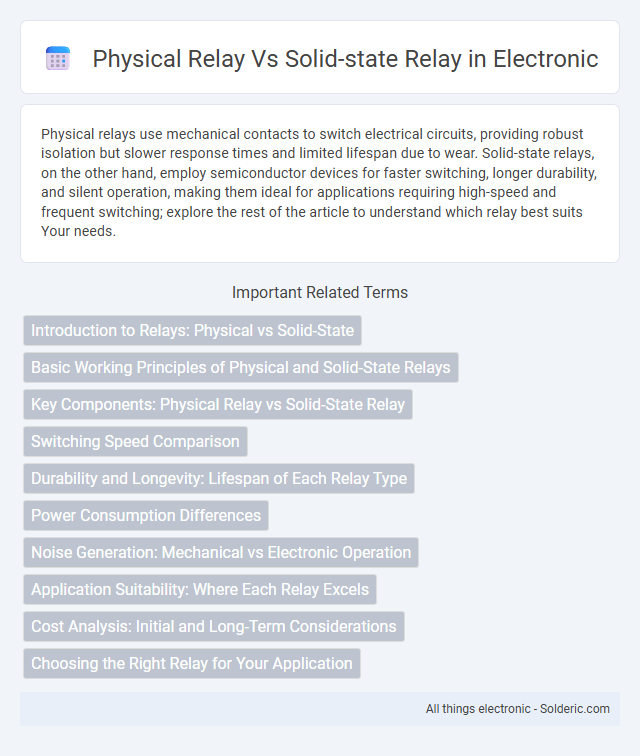Physical relays use mechanical contacts to switch electrical circuits, providing robust isolation but slower response times and limited lifespan due to wear. Solid-state relays, on the other hand, employ semiconductor devices for faster switching, longer durability, and silent operation, making them ideal for applications requiring high-speed and frequent switching; explore the rest of the article to understand which relay best suits Your needs.
Comparison Table
| Feature | Physical Relay | Solid-State Relay |
|---|---|---|
| Operating Principle | Electromechanical switch with moving contacts | Electronic switching using semiconductor devices |
| Switching Speed | 10-20 milliseconds | Microseconds to milliseconds |
| Durability | Limited mechanical lifespan (~10^5 to 10^7 operations) | High lifespan (>10^9 operations), no mechanical wear |
| Noise | Audible clicking sound | Silent operation |
| Size | Larger due to mechanical parts | Compact and lightweight |
| Power Consumption | Higher coil power consumption | Lower power consumption |
| Contact Isolation | Physical contact provides good isolation | Opto-isolation or zero-cross detection |
| Cost | Generally lower initial cost | Higher upfront cost, lower maintenance |
| Applications | High voltage switching, heavy loads | Fast switching, sensitive electronics, noise critical |
Introduction to Relays: Physical vs Solid-State
Physical relays use electromagnetic coils to mechanically open or close contacts, offering clear isolation and durability in high-current applications. Solid-state relays (SSRs) rely on semiconductor components like thyristors or transistors for switching, providing faster response times, silent operation, and longer life without mechanical wear. Comparing switching speed, lifespan, and noise levels highlights SSRs as ideal for precision control, while physical relays excel in heavy-duty and electromagnetically noisy environments.
Basic Working Principles of Physical and Solid-State Relays
Physical relays operate using an electromagnetic coil that mechanically moves contacts to open or close a circuit, enabling electrical isolation and switching. Solid-state relays use semiconductor components such as thyristors, triacs, or transistors to switch circuits without moving parts, offering faster response times and increased durability. The fundamental difference lies in mechanical movement for physical relays versus electronic switching in solid-state relays, impacting performance and applications.
Key Components: Physical Relay vs Solid-State Relay
Physical relays consist of an electromagnetic coil, movable armature, and mechanical contacts that open or close circuits through mechanical movement. Solid-state relays use semiconductor components such as thyristors, triacs, or transistors, and optocouplers to achieve switching without moving parts. These key components in solid-state relays enable faster switching speeds and longer operational life compared to the mechanically driven design of physical relays.
Switching Speed Comparison
Physical relays typically exhibit switching speeds ranging from 5 to 20 milliseconds, which can limit their use in high-speed applications. Solid-state relays (SSRs) switch much faster, often within microseconds to a few milliseconds, due to the absence of mechanical parts. Your choice between these relays depends on the required switching speed for your specific application, with SSRs favored for rapid, repetitive switching tasks.
Durability and Longevity: Lifespan of Each Relay Type
Physical relays typically have a lifespan ranging from 100,000 to 10 million mechanical operations due to their moving parts, which are prone to wear and failure over time. Solid-state relays (SSRs) offer significantly longer durability with lifespans often exceeding 100 million cycles since they use semiconductor components with no mechanical motion. SSRs also exhibit higher reliability in harsh environments by resisting vibration, shock, and electrical noise more effectively than physical relays.
Power Consumption Differences
Physical relays consume more power due to the electromagnetic coil required to switch contacts, leading to higher energy usage during operation. Solid-state relays (SSRs) use semiconductor components with minimal power draw, resulting in significantly lower energy consumption and improved efficiency. Your choice impacts overall power efficiency, especially in systems with frequent switching cycles.
Noise Generation: Mechanical vs Electronic Operation
Physical relays generate noise due to mechanical contact movement, resulting in audible clicks and electromagnetic interference during switching. Solid-state relays operate electronically with no moving parts, producing minimal noise and eliminating mechanical wear and contact arcing. This difference makes solid-state relays ideal for noise-sensitive and high-reliability applications where silent operation is critical.
Application Suitability: Where Each Relay Excels
Physical relays excel in high-voltage, high-current applications such as industrial machinery and heavy equipment due to their robust mechanical switching capabilities and ability to handle overloads. Solid-state relays are ideal for fast, silent switching in low-voltage applications like home automation, HVAC systems, and electronic devices, benefiting from their durability and lack of mechanical wear. Selecting between physical and solid-state relays depends on factors like switching speed, load type, electrical noise tolerance, and maintenance requirements.
Cost Analysis: Initial and Long-Term Considerations
Physical relays generally have lower initial costs due to simpler components and manufacturing processes, making them cost-effective for basic applications. Solid-state relays (SSRs) entail higher upfront expenses because of advanced semiconductor materials and circuitry but offer longer operational lifespans and minimal maintenance. Over time, SSRs reduce total cost of ownership through energy savings, enhanced reliability, and elimination of mechanical wear and replacement parts.
Choosing the Right Relay for Your Application
Choosing the right relay for your application depends on factors like switching speed, load type, and durability. Physical relays offer mechanical isolation and handle high current loads but have slower response times and shorter lifespans. Solid-state relays provide faster switching, longer service life, and silent operation, making them ideal for applications requiring frequent cycling and precise control.
physical relay vs solid-state relay Infographic

 solderic.com
solderic.com